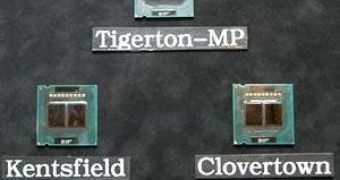Intel has demonstrated its new multi-processor server platform along with its next-generation server chip for multi-processor machines, showed Xbitlabs. The demo seems to be designed as to show the company's clients and investors that the new Intel Xeon MP product is essentially ready and the company is on-track to ship it in the Q3 of 2007.
Intel kept quiet as regarding to the code-named Tigerton processor details, according to media reports; however, it was still announced that the new chip along with the Caneland platform will use a chipset code-named Clarksboro which supports fully-buffered dual-in-line memory modules (FB-DIMMs) and will have four dedicated processor buses (one link per processor); as a result, Tigerton processors will not have built-in memory controller and the whole platform will still use several processor system buses instead of one common interconnection akin to the HyperTransport bus.
The Tigerton processor has the first chip for MP machines that is based on the energy efficient Core 2 micro-architecture. The chip was included into the roadmap back in late 2005 to substitute the code-named Whitefield microprocessor just months after the company publicly demonstrated a roadmap at Intel Developer Forum Fall 2005 that showcased Whitefield and Dunnington chips due to arrive in 2007. Intel said that changes in plans were conditioned by an intention to offer higher performance.
The fundamental difference between the Caneland platform and the Redland platform is that the former supports so-called dedicated high-speed interconnection. In the end, according to what Intel claims, is seems Whitefield chips were supposed to share a processor system bus in multiprocessor system, whereas Tigerton processors are expected to get dedicated interconnection to the rest of the system.
Back in the summer of 2005, an Intel partner said that - in 2007 - Intel server platforms would use common serial interconnect (CSI) bus instead of the traditional processor system bus and some processors will have built-in memory controller. The first of such chips was projected to be Tukwila, a multi-core Intel Itanium processor, which is, after the Montecito delay, scheduled for 2008. The sources show that it is highly likely that the "dedicated high-speed interconnect" of the Caneland has is a more advanced version of the dual independent bus used in the Truland platforms and Bensley platforms. In order to compensate relatively low processor system bus bandwidth, Intel has to integrate large 16MB level three cache (L3) into its current Intel Xeon 7100-series microprocessors. Intel did not specify the capacity of L3 cache of the Tigerton microprocessors.

 14 DAY TRIAL //
14 DAY TRIAL //